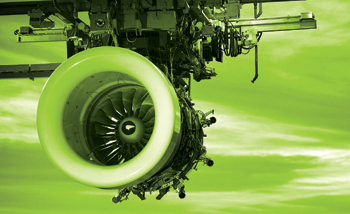Environment - Green Engines Are Coming

Looming large on the horizon are mandatory emissions targets, taxes, carbon trading allowance and further regulations towards reducing greenhouse gas emissions. Whatever the ultimate solution, the industry needs to come to terms with the fact that environment issues affecting aviation are only going to become more prominent in the years to come.
Let’s face it. In the current environment, where climate change is swiftly rising to the number one spot on the international agenda, aviation is attracting some bad press. It is no use insisting that airliners today can fly three times as far with a given amount of fuel as they did 40 years ago. It is pointless claiming that engine fuel efficiency has improved 20 per cent in the past decade and 5 per cent in the last two years alone, thus significantly reducing emissions. It is futile to declare that this process could well lead to a cut of another 50 per cent of greenhouse gas emissions by 2050. The problem is that the layman sees and hears the huge aircraft engines. He intuitively feels that they must be emitting large amounts of noxious products and that something should be done about it soon! Now, other industries are also not likely to come out in support of aviation. It is estimated that to meet the UK’s EU mandated 60 per cent overall emissions cut target by 2050, every other industry in the UK would have to cut emissions by around 80 per cent in order to compensate for the rising emissions created by aviation.
Aviation is swiftly becoming the favourite whipping boy of the green brigade because it has always been a high profile industry. It cannot be denied that air travel is the fastest-growing source of greenhouse gases and its rapid expansion risks undermine progress in reducing emissions in other areas. For instance, after factoring in a 50 per cent improvement in aircraft efficiency, a further doubling of aircraft emissions by 2050 is likely in the UK. A similar story can be told of most of the developed and emerging economies. The reason is clear. Since the emergence of low-budget airlines in the 1990s, the number of people choosing to take flights has seen a colossal increase. This is boom time for aircraft manufacturers with the order books full and long waiting lists for new aircraft. Boeing predicts that the global commercial fleet will more than double to 36,000 aircraft by 2025. Governments all over the world and politicians of every hue are getting into the green act with the EU taking the lead in pushing for a global cut in emissions. The Kyoto Protocol of 1997 commits EU members to cut their CO2 emissions by 8 per cent below the level of 1990, and this cut is to be achieved no later than 2012. Some governments have acknowledged the need to cut total emissions by 60 per cent by 2050. In fact, scientists believe that a 90 per cent cut by 2050 may be necessary, but protest in the same breath that this is unachievable given the current lack of political will for hard decisions.





